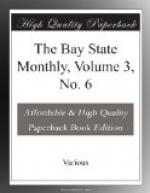It is only as a patriot that Samuel Adams claims our attention. Although college bred he was a man of letters only so far as his pen could write patriotic resolutions and scathing letters against the government of King George. These letters were printed for the most part in the “Boston Gazette,” published by Edes & Gill in Court Street. As a business man he was never a success. For years he kept the old malt house on Purchase Street, but he gave the business little thought, for his mind was constantly engrossed in public matters, and at last he made no pretext of attending to any matter of private business, depending for support only upon his small salary as clerk of the assembly. No one will ever accuse Samuel Adams of any selfish ambition, and, although his every act will not bear the closest application of the square and rule, yet he never deceived nor used a doubtful method in the least degree for personal gain.
Adams did not begin his public career early in life. In 1764 he was chosen a member of the committee to instruct the representatives just elected to the General Court, and the paper drafted on that occasion is the first document from his pen of which we now have any trace, and is memorable, moreover, because it contains the first public denial of the authority of the Stamp Act. Adams was now forty-two, his hair was already touched with gray, and “a peculiar tremulousness of the head and hands made it seem as if he were already on the threshold of old age.” He had, however, a remarkably sound constitution, a medium sized, muscular frame, and clear, steel-gray eyes.
[Illustration: OLD STATE HOUSE IN 1793.]
Among those closely connected with Adams in the public service, which, from this time on, became his only thought, were John Hancock and James Otis. Adams contrasted strongly with both of these men. Hancock was the richest man in the province and as liberal as he was wealthy. In the general jubilation that followed the repeal of the Stamp Act, he opened a pipe of Madeira wine before his elegant mansion opposite the Common, and so long as it lasted it was freely dispensed to the crowd. The dress of Hancock when at home is described as a “red velvet cap, within which was one of fine linen, the edge of this turned up over the velvet one, two or three inches. He wore a blue damask gown lined with silk, a white plaited stock, a white silk embroidered waistcoat, black silk small-clothes, white silk stockings and red morocco slippers.” Adams was in marked contrast with Otis in temperament. The former, always cool and collected and his words based on deliberate reason, was the extreme of the other who carried his arguments in a flood of impetuous eloquence. “Otis was a flame of fire,” says Sewall. But although Otis was once almost the ideal of the people, his erratic tendencies at last unfitted him for a leader.




